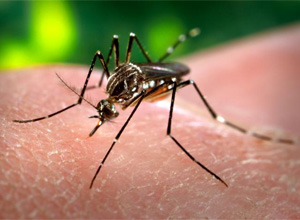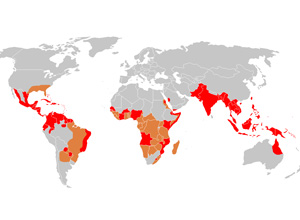This page has been archived and is no longer updated

Dengue infection, which can cause high fever, headache, rash, severe joint and muscle pain, hemorrhage, and death, is a disease usually associated with tropical countries. Yet in the summer and fall of 2009, 22 cases of dengue infection were confirmed in Key West, Florida. Although the number of cases was small, they were noteworthy: These infections were not spread by travelers returning from endemic countries; they were the first locally transmitted infections in Florida in more than forty years. According to the National Institute of Allergy and Infectious Diseases, the risk of further dengue outbreaks in the United States is growing. Dengue infection is caused by any of four related viruses that are transmitted to humans by the mosquitoes Aedes albopictus (Asian tiger mosquito) and Aedes aegypti. Both of these bugs now live in the US. A. albopictus has been found in 36 states while A. aegypti has been found in several southern states. Experience has shown that where these mosquitoes go, dengue infection often follows.
The prospect of dengue epidemics is disturbing because there is no vaccine against dengue; nor have any specific antiviral medications shown to be effective to treat it. Dengue is a particularly tricky disease because it is caused by any one of four closely related flaviviruses. An effective vaccine would need to induce the immune system to produce antibodies against all four dengue virus serotypes, a task that so far has proven too difficult to accomplish. The fourfold dengue foe has also made the development and testing of antiviral medications complicated and expensive. Research funding for dengue and other "neglected" tropical diseases has historically been difficult to come by. Most research advances in the field of dengue prevention and treatment have come through the efforts of government agencies and pharmaceutical companies that are conducting philanthropic research. Despite these efforts, the only existing ways to prevent and control dengue infection are to control the mosquito populations responsible for transmitting the disease and to avoid being bitten by infected mosquitoes.
In this Spotlight, you will learn more about the viruses that cause dengue infection, the mosquitoes responsible for transmitting them, and the challenges scientists must overcome in order to produce a vaccine and effective dengue treatments. You will also learn about the latest research in mosquito control, including the use of genetically modified "flightless" mosquitoes. In addition, clinicians will find links to guidelines for the diagnosis, treatment, and clinical management of dengue infection — information that may be useful, in the event of future dengue outbreaks, to those who have never seen the disease in clinical practice.
Image: James Gathany/CDC.
Learn about the etiology and symptoms of dengue infection from the CDC.
See how the dengue viruses mature and become infectious to humans.
The WHO maintains a central data management system for the global surveillance of dengue infection.
See why repeated infections with different viral strains raise the risk of dengue hemorrhagic fever — and what this means for developing a vaccine.
Read about the efforts being made to discover and develop small molecule antiviral medications for dengue.
This PLoS research report summarizes how human proteins and the dengue connectome interact.
Watch the life cycle of the mosquito most commonly responsible for transmitting dengue infection among humans.
Cases of dengue infection are on the rise in the Americas. Could climate change be playing a role?
Dengue has come to the US. See how Florida Keys Mosquito Control is attempting to fight back.
Can scientists force female mosquitoes to carry insecticides that will kill their own offspring?
See how infecting mosquitoes with the bacterium Wolbachia interferes with their ability to transmit dengue.
Genetically modified mosquitoes are being tested as a way to drastically reduce the mosquito population.
Learn about the three clinical presentations of dengue infection: undifferentiated fever, dengue fever with or without hemorrhage, and dengue hemorrhagic fever or dengue shock syndrome.
The World Health Organization provides diagnosis and treatment guidelines for clinicians.
A high-accuracy clinical algorithm differentiates dengue from other febrile illness.
